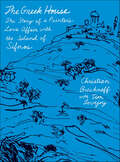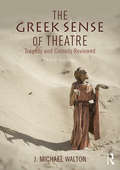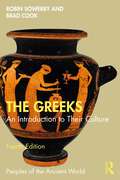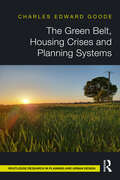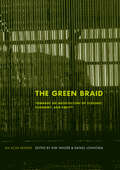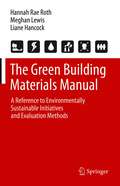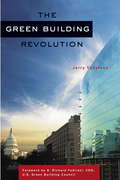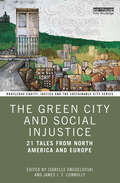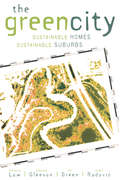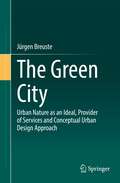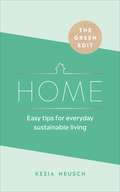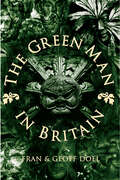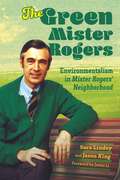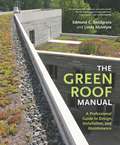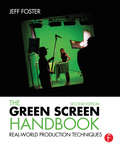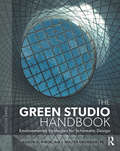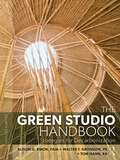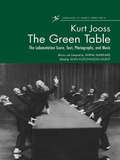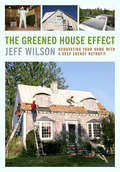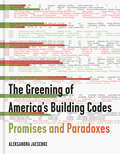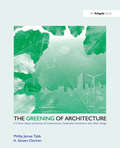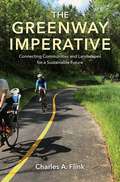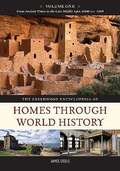- Table View
- List View
The Greek House: The Story of a Painter's Love Affair with the Island of Sifnos
by Christian Brechneff Tim LovejoyA richly rewarding narrative about a young painter's love affair with the Greek island of SifnosWhen Christian Brechneff first set foot on the Greek island of Sifnos, it was the spring of 1972 and he was a twenty-one-year-old painter searching for artistic inspiration and a quiet place to work. There, this Swiss child of Russian émigrés, adrift and confused about his sexuality, found something extraordinary. In Sifnos, he found a muse, a subject he was to paint for years, and a sanctuary. In The Greek House, Brechneff tells a funny, touching narrative about his relationship to Sifnos, writing with warmth about its unforgettable residents and the house he bought in a hilltop farm village. This is the story of how he fell in love with Greece, and how it became a haven from the complexities of his life in Western Europe and New York. It is the story of his village and of the island during the thirty-odd years he owned the house—from a time when there were barely any roads, to the arrival of the modern world with its tourists and high-speed boats and the euro. And it is the story of the end of the love affair—how the island changed and he changed, how he discovered he had outgrown Sifnos, or couldn't grow there anymore.The Greek House is a celebration of place and an honest narrative of self-discovery. In its pages, a naïve and inexperienced young man comes into his own. Weaving himself into the life of the island, painting it year after year, he finds a place he can call home.
The Greek Playwright: What the First Dramatists Have To Say To Contemporary Playwrights
by Clem MartiniPicking up where The Blunt Playwright left off, Clem Martini returns to the subject of playwriting, turning his attention to the lessons modern playwrights can learn from the ancient Greeks. Outlining the major playwrights of the era, their major works, and the impact they had on our modern understanding of drama, Martini weaves his direct, informative, and entertaining style through centuries of dramatic evolution to show us exactly what the first dramatists have to say to contemporary playwrights.
The Greek Sense of Theatre: Tragedy and Comedy
by J Michael WaltonIn this updated and extended edition of The Greek Sense of Theatre, scholar and practitioner J.Michael Walton revises and expands his visual approach to the theatre of classical Athens. From the tragedies of Aeschylus, Sophocles and Euripides to the old and new comedies of Aristophanes and Menander, he argues that while Greek drama is seen now as a performance-based rather than a strictly literary medium, more attention should still be paid to the nature of stage image and masked acting as part of this conception.
The Greeks: An Introduction to Their Culture (Peoples of the Ancient World)
by Robin Sowerby Brad CookThis fully revised, new edition of The Greeks is a concise but wide-ranging introduction to the culture of ancient Greece, providing a comprehensive survey that covers all the key elements of ancient Greek civilisation from the age of Homer to the Hellenistic period.It opens with an overview of ancient historical sources and their authors and perspectives before delving into early history, legends and excavations, and the famed age of classical Greece. Chapters follow on politics, religion, daily life, literature, philosophy, and art and architecture, with a concluding chapter on the Greek world following the death of Alexander the Great and during the Roman era. This new edition features: greater discussion of underrepresented groups, especially women and slaves; a chapter on ancient politics that provides a comparison of an ancient aristocracy, democracy, and monarchy in Sparta, Athens, and Macedon; new and revised images, all now with detailed captions to merge the artefacts and texts more fully and bring the narrative to life for every reader; and new translations of all ancient passages revised for accuracy and clarity. Clearly written, with generous references to original source material, The Greeks places ancient Greek culture firmly in its political, social, and historical context.The fourth edition of The Greeks remains an invaluable introduction for all students of Classics and an indispensable guide for students of other disciplines who require grounding in ancient Greek civilisation and history.
The Green Belt, Housing Crises and Planning Systems (Routledge Research in Planning and Urban Design)
by Charles Edward GoodeThis book evaluates the effectiveness of the Green Belt planning policy in England. It is one of the most well-known strategies internationally, with similar growth restraint policies having been adopted in a diverse range of cities around the world, such as Portland, Medellin and Bangkok. Despite this, it is often argued that Green Belts contribute to wider inequitable outcomes in society.Focusing on the Green Belt in England, the book critically analyses the extent to which these policies and planning systems contribute to housing crises and examines how far they need to be reformed. With the central role of community engagement in many of the debates about housing crises, the book investigates the characteristics of popular and campaigner opposition to housebuilding alongside investigating the power relations and politics of planning systems. This timely research taps into important current policy debates in the UK surrounding urban nature, green infrastructure, and building on the ‘grey belt’.The book is therefore of relevance and benefit to policymakers and politicians, to academics and students internationally from a range of fields interested in housing, community engagement, green infrastructure, strategic planning, power and politics, and conservation.
The Green Braid: Towards an Architecture of Ecology, Economy and Equity (The ACSA Architectural Education Series)
by Kim Tanzer Rafael LongoriaThis volume presents the discipline’s best thinking on sustainability in written, drawn, and built form, drawing on over fifteen years of peer-reviewed essays and national design awards published by the Association of Collegiate Schools of Architecture (ACSA). Providing a primer on sustainability, useful to teachers and students alike, the selected essays address a broad range of issues. Combined with design projects that highlight issues holistically, they promote an understanding of the principles of sustainability and further the integration of sustainable methods into architectural projects. Using essays that alternately revise and clarify twentieth century architectural thinking, The Green Braid places sustainability at the centre of excellent architectural design. No other volume addresses sustainability within the context of architectural history, theory, pedagogy and design, making this book an ideal source for architects in framing their practices, and therefore their architectural production, in a sustainable manner.
The Green Building Materials Manual: A Reference to Environmentally Sustainable Initiatives and Evaluation Methods
by Hannah Rae Roth Meghan Lewis Liane HancockEvaluating building materials for environmental sustainability is a complex prospect. How do governmental agencies and the design industry actually measure sustainable initiatives and environmental impacts? This book breaks down the technical vocabulary and principles that define environmentally sustainable choices across interior and exterior architectural products to help the reader understand: Material ingredient selectionEnergy and water useEmissions, including greenhouse gasesHuman health and toxicitySocial accountability assessment This guide explains the structure of green certifications, standards and ecolabels, life cycle assessment, environmental regulations, and more. It presents a historic timeline for context and a snapshot of current trends and future objectives. It is a comprehensive reference for interior designers, architects, building owners, contractors, and students enrolled in interior design and architecture.
The Green Building Revolution
by Jerry Yudelson S. Richard FedrizziThe "green building revolution'' is happening right now. This book is its chronicle and its manifesto. Written by industry insider Jerry Yudelson, The Green Building Revolution introduces readers to the basics of green building and to the projects and people that are advancing this movement. With interviews and case studies, it does more than simply report on the revolution; it shows readers why and how to start thinking about designing, building, and operating high performance, environmentally aware (LEED-certified) buildings on conventional budgets. Evolving quietly for more than a decade, the green building movement has found its voice. Its principles of human-centered, environmentally sensitive development have reached a critical mass of architects, engineers, builders, developers, professionals in government, and consumers. Green buildings are showing us how we can have healthier indoor environments that use far less energy and water than conventional buildings do. The federal government, eighteen states, and nearly fifty U.S. cities already require new public buildings to meet "green" standards. According to Yudelson, this is just the beginning. The Green Building Revolution describes the many "revolutions" that are taking place today: in commercial buildings, schools, universities, public buildings, health care institutions, housing, property management, and neighborhood design. In a clear, highly readable style, Yudelson outlines the broader "journey to sustainability" influenced by the green building revolution and provides a solid business case for accelerating this trend. Illustrated with more than 50 photos, tables, and charts, and filled with timely information, The Green Building Revolution is the definitive description of a major movement that's poised to transform our world.
The Green City and Social Injustice: 21 Tales from North America and Europe (Routledge Equity, Justice and the Sustainable City series)
by Isabelle Anguelovski and James J. T. ConnollyThe Green City and Social Injustice examines the recent urban environmental trajectory of 21 cities in Europe and North America over a 20-year period. It analyses the circumstances under which greening interventions can create a new set of inequalities for socially vulnerable residents while also failing to eliminate other environmental risks and impacts. Based on fieldwork in ten countries and on the analysis of core planning, policy and activist documents and data, the book offers a critical view of the growing green planning orthodoxy in the Global North. It highlights the entanglements of this tenet with neoliberal municipal policies including budget cuts for community initiatives, long-term green spaces and housing for the most fragile residents; and the focus on large-scale urban redevelopment and high-end real estate investment. It also discusses hopeful experiences from cities where urban greening has long been accompanied by social equity policies or managed by community groups organizing around environmental justice goals and strategies. The book examines how displacement and gentrification in the context of greening are not only physical but also socio-cultural, creating new forms of social erasure and trauma for vulnerable residents. Its breadth and diversity allow students, scholars and researchers to debunk the often-depoliticized branding and selling of green cities and reinsert core equity and justice issues into green city planning—a much-needed perspective. Building from this critical view, the book also shows how cities that prioritize equity in green access, in secure housing and in bold social policies can achieve both environmental and social gains for all.
The Green City: Sustainable Homes, Sustainable Suburbs
by Nicholas Low Brendon Gleeson Ray Green Darko RadovicA team of city-building professionals explain in straightforward terms how the idea of ecological sustainability can be embodied in the everyday life of homes, communities and cities to make a better future.The book considers - and answers - three questions: What does the global agenda of sustainable development mean for the urban spaces where most people live, work and move? Can we keep what we love about suburban life and still save the environment? And what new methods of planning and building will be needed in the 21st century? Rejecting both economic and environmental orthodoxy, the book’s essential message is that the sustainable city can be built by a thousand well-directed small changes. It draws on practical case material from around the world and weaves together four critical aspects of urban life: housing, open space, workplaces and transport. A 'photographic essay' of 32 colour plates illustrates the ideas discussed.
The Green City: Urban Nature as an Ideal, Provider of Services and Conceptual Urban Design Approach
by Jürgen BreusteThis textbook on the Green City examines urban nature as an ideal, provider of services and conceptual urban design approach. It answers important contemporary questions that arise about the ecological and cultural interactions, development and structure, and ecological performance of urban nature worldwide. The book explains what urban nature is, how it came to be, and how it evolved in the context of the natural and cultural conditions of its sites. It also describes what constitutes urban biodiversity and the role of differentiated urban nature in the Green City concept. Theories of urban development and ecology are linked to practical applications of urban planning and illustrated with many case studies and examples. The great potentials of urban nature are shown in detail. In order to cope with or mitigate problems in the city, a targeted urban nature management adapted to the specific conditions of the different types of urban nature is needed, which includes nature conservation as well as nature design, always keeping in mind the relation to the urban dwellers. The textbook is especially addressed to students and teachers of urban planning, ecology, geography, social sciences as well as practitioners of urban design and nature conservation. This book is a translation of the original German 1st edition Die Grüne Stadt by Jürgen Breuste, published by Springer-Verlag GmbH Germany, part of Springer Nature in 2019. The translation was done with the help of artificial intelligence (machine translation by the service DeepL.com). A subsequent human revision was done by the author primarily in terms of content and scientific terms, so that the book will read stylistically differently from a conventional translation but without loss of messages. Springer Nature works continuously to further the development of tools for the production of books and on the related technologies to support the authors.
The Green Edit: Easy tips for everyday sustainable living
by Kezia NeuschCreate a happy, beautiful and eco-friendly homeHaving a happy, healthy home is a key part of our wellbeing, but how do we ensure the pursuit of our perfect living space doesn't negatively impact on the environment?Blogger and low-waste expert Kezia Neusch provides simple swaps and genius hacks to help you reduce your household’s ecological footprint, covering everything from how to break up with your tumble dryer and why your mid-morning snack might be harming the planet.This book contains everything you need to know to create a sustainable home for you and your family.
The Green Imperative: Ecology and Ethics in Design and Architecture
by Victor PapanekA fresh edition of the sustainable design pioneer Victor Papanek’s classic and ever-relevant book examining the important role of design in combating climate change. Whether it’s horror at the plastic littering the world’s beaches or despair at the melting polar ice caps, the world is gradually waking up to the impending climate disaster. In The Green Imperative, Papanek argues for design that addresses these issues head-on. This means using materials that can be recycled and reused, no more pointless packaging, thinking about how products make us feel and engage all our senses, putting nature at the heart of design, working at a smaller scale, rejecting aesthetics for their own sake, and thinking before we buy. First published at the end of the twentieth century, this book offered a plethora of honest advice, clear examples, and withering critiques, laying out the flaws of and opportunities for the design world at that time. A quarter of a century on, Papanek’s lucid prose has lost none of its verve, and the problems he highlights have only become more urgent, giving today’s reader both a fascinating historical perspective on the issues at hand and a blueprint for how they might be solved.
The Green Man in Britain
by Fran Doel Geoff DoelThe Green Man has many facets, many dimensions. He peers through his leaf mask in hundreds of church misericords and stone carvings. His innate link with the changing seasons and fertility is revealed in the medieval poem Sir Gawain and the Green Knight and in summer folk customs such as Jack in the Green, the Castleton Garland and the Burry Man. Perhaps he even lurks in the legendary hero of the Greenwood, Robin Hood. The Authors have been running summer schools and courses on the Green Man for many years, and in this fascinating study they discuss his significance in medieval times and explore the modern development of the concept of the Green Man. The book also contains a detailed gazetteer of over 200 sites, featuring almost 1000 carvings (many photographed by Felicity Howlett).
The Green Mister Rogers: Environmentalism in Mister Rogers' Neighborhood (Children's Literature Association Series)
by Jason King Sara LindeyFred Rogers was an international celebrity. He was a pioneer in children’s television, an advocate for families, and a multimedia artist and performer. He wrote the television scripts and music, performed puppetry, sang, hosted, and directed Mister Rogers’ Neighborhood for more than thirty years. In his almost nine hundred episodes, Rogers pursued dramatic topics: divorce, death, war, sibling rivalry, disabilities, racism. Rogers’ direct, slow, gentle, and empathic approach is supported by his superior emotional strength, his intellectual and creative courage, and his joyful spiritual confidence. The Green Mister Rogers: Environmentalism in “Mister Rogers’ Neighborhood” centers on the show’s environmentalism, primarily expressed through his themed week “Caring for the Environment,” produced in 1990 in coordination with the twentieth anniversary of Earth Day. Unfolding against a trash catastrophe in the Neighborhood of Make-Believe, Rogers advances an environmentalism for children that secures children in their family homes while extending their perspective to faraway places, from the local recycling center to Florida’s coral reef. Rogers depicts animal wisdom and uses puppets to voice anxiety and hope and shows an interconnected world where each part of creation is valued, and love is circulated in networks of care. Ultimately, Rogers cultivates a practical wisdom that provides a way for children to confront the environmental crisis through action and hope and, in doing so, develop into adults who possess greater care for the environment and a capacious imagination for solving the ecological problems we face.
The Green Roof Manual: A Professional Guide to Design, Installation, and Maintenance
by Linda McIntyre Edmund C. SnodgrassGreen roofs—the ultimate in sustainable building practices—continue to generate enormous interest and enthusiasm among architects, landscape designers, and urban planners. Increasingly strict stormwater regulations and the appeal of LEED-related projects have also boosted the popularity and desirability of green roofs. Those who want to build green roofs, however, have few resources to guide them. Until now, no book has taken a comprehensive look at how to effectively adapt green-roof technology to the variable and extreme North American climate, and how to design projects that will function and endure as successfully as those in Germany, Switzerland, and other European countries. This book fills the gap by providing an overview of practices and techniques that have been effective in North America. The authors offer options regarding structure, function, horticulture, and logistics, as well as surveys of actual projects and analyses of why they have or haven’t succeeded. Approachable and reader-friendly, the manual clearly explains how these complex systems function and how to plan and carry out projects successfully from concept through construction and maintenance. Ideally suited to professionals (including architects, landscape architects, engineers, and designers) and their clients, it brings together key lessons from leaders in the field. Numerous photographs highlight the range of design possibilities and show green roofs both during construction and at various stages of maturity. At last, those seeking basic information about how to design and build green roofs have a concise, authoritative guide to this exciting new technology.
The Green Screen Handbook: Real-World Production Techniques
by Jeff FosterThe Green Screen Handbook, Second Edition is a comprehensive how-to manual that walks you through the many integral techniques required in preproduction, production, and postproduction to use green screen effectively. Step-by-step instruction and time-saving tips cover matting and keying basics; lighting and digital camera essentials; setups using fabric, portable background panels, and paint; broadcast TV hardware switchers; professional HD and major motion picture compositing; multi-colored screen composites; directing storyboards and talent; working with virtual sets; motion tracking; and much more. Additionally, this new edition has been updated to include: Coverage of the latest digital camera technologies, lighting gear, and compositing and editing software Advice on using apps for portable devices that will help you light and shoot better green screen Examples and case studies of real-world green screen and compositing projects in film and television productions An extensive companion website (www.focalpress.com/cw/foster) featuring downloadadble project files and streaming video tutorials You can’t afford to miss out! The Green Screen Handbook, Second Edition is a one-stop shop for all of your green screen solutions.
The Green Studio Handbook: Environmental Strategies for Schematic Design
by Alison G Kwok Walter GrondzikThe Green Studio Handbook remains an essential resource for design studios and professional practice. This extensive and user-friendly tool presents practical guidelines for the application of green strategies during the schematic design of buildings. Students and professionals can quickly get up to speed on system viability and sizing. Each of forty-three environmental strategies includes a brief description of principles and concepts, step-by-step guidance for integrating the strategy during the early stages of design, annotated tables and charts to assist with preliminary sizing, key issues to consider when implementing the strategy, and pointers to further resources. Ten new in-depth case studies illustrate diverse and successful green buildings integrated design projects and how the whole process comes together This third edition features updated tables and charts that will help to save energy, water, and material resources during the early stages of design. More than 500 sketches and full-color images illustrate how to successfully apply strategies. A glossary, a project index listing 105 buildings in 20 countries, updated tables and drawings, and I-P and SI units increase the usefulness of The Green Studio Handbook.
The Green Studio Handbook: Strategies for Decarbonization
by Walter T. Grondzik Alison G. Kwok Tom HahnMaking the complexities of green architecture accessible to the design studio, The Green Studio Handbook remains a must-read for current and future architects. The heart of this book provides 43 comprehensive design strategies covering the building envelope, lighting, heating, cooling, energy and electricity, and water and waste – each with a description, key architectural issues, implementation considerations, and a step-by-step design procedure for integration early in the design process. Each design strategy has been thoroughly reviewed and updated to reflect the latest evidence-based guidance, best practices, and standards in consideration of all climatic zones.In addition to more than 80 building examples provided throughout, ten in-depth case studies illustrate successful integration of numerous strategies.All case studies are brand-new to this fourth edition and include a wide range of building types, from the USA, Colombia, Rwanda, Malaysia, Denmark, Bhutan, Canada, and Australia.Envelope design strategies have been significantly revised and expanded to include new strategies on: Foundation systems for the reduction of embodied carbon Framing systems using mass-timber, bamboo, and other natural material-based systems Low-complexity wall systems using "natural" elements such as earth, lime, straw, and hemp High-complexity wall systems for enhanced thermal performance and strength Additional roofing systems beyond green roofs
The Green Table: The Labanotation Score, Text, Photographs, and Music
by Ann Hutchinson Guest* Score, photographs, and production details of one of this century's best-loved ballets * Includes rare archival material * Packaged with audio CD This work brings together the complete dance score of The Green Table--one of the most famous ballets of the 20th century--in Labanotation, along with music notation for the piano accompaniment and a complete recording of the accompaniment on CD. It also includes several essays about the work and its genesis, and many historic production photographs. This book is an important item for all colleges with dance programs to own in their libraries and for scholars interested in the study of contemporary dance.
The Greened House Effect
by Jeff WilsonWith greater public awareness of the need for energy independence, the issue of how we can make our existing homes more resource efficient is becoming ever more critical. Residential buildings make up a large fraction of our energy needs, largely due to heating and air-conditioning. So it's no longer enough to simply do the small stuff, like switching to compact fluorescent bulbs, or turning down the thermostat at night. In The Greened-House Effect, author Jeff Wilson brings his twenty-five years of construction experience and knowledge of home building to bear on making our current houses cleaner, greener, and healthier. Think of a deep-energy retrofit (DER) as a "home makeover" - one that represents a significant investment, but that saves money from the get-go by capturing the energy you "drop on the ground" every month, every year, through inefficiency, poor design, or simply living in a typical older home. Using his own family's DER of their 1942 home as a prime example, Wilson weaves a readable narrative at a practical, hammer-and-nail level. He presents the solutions to our building and energy problems, making them seem possible for average homeowners and small contractors by offering the right set of information, skills, and materials. More technical information is presented in sidebars and graphs, and numerous color photos illustrate the process, including: Testing the energy efficiency of your home and learning where improvements need to be made Issues of local building codes and regulations Financing and paying for a DER Major components of the DER, such as roofs, exterior walls, basements, and home systems Wilson's building experience, along with his lifelong passion for energy issues, all come together to form an inspirational, can-do approach to making our neighborhood, our community, our nation, and our world a better place - one home at a time.
The Greening of America's Building Codes: Promises and Paradoxes
by Aleksandra JaeschkeEnvironmental disasters and severe weather due to climate change, both triggered by human actions, have had an increasingly direct impact on our homes. But the way in which America builds its homes is part of the problem. This deeply researched history of sustainable design standards in building codes explores how public policy, standard-setting trade associations, and financial incentives influence the ways in which the construction of our homes impacts the environment.The Greening of America's Building Codes investigates the regulations and economic incentives meant to control the environmental impact of contemporary construction practices as it analyzes the history of residential building codes. The book exposes how the socioeconomic and political forces that influenced early building code development continue to define the character of current building codes and, by extension, determine how we regulate environmental impact and define sustainability today.More relevant than ever, The Greening of America's Building Codes is a valuable tool for architects, architecture students, builders, real estate developers, and homeowners who want to understand how public policy and their own day-to-day decisions impact the environment.
The Greening of Architecture: A Critical History and Survey of Contemporary Sustainable Architecture and Urban Design
by Phillip James Tabb A. Senem DevirenContemporary architecture, and the culture it reflects dependent as it is on fossil fuels, has contributed to the cause and necessity of a burgeoning green process that emerged over the past half century. This text is the first to offer a comprehensive critical history and analysis of the greening of architecture through accumulative reduction of negative environmental effects caused by buildings, urban designs and settlements. Describing the progressive development of green architecture from 1960 to 2010, it illustrates how it is ever evolving and ameliorated through alterations in form, technology, materials and use and it examines different places worldwide that represent a diversity of cultural and climatic contexts. The book is divided into seven chapters: with an overview of the environmental issues and the nature of green architecture in response to them, followed by an historic perspective of the pioneering evolution of green technology and architectural integration over the past five decades, and finally, providing the intransigent and culturally pervasive current examples within a wide range of geographic territories. The greening of architecture is seen as an evolutionary process that is informed by significant world events, climate change, environmental theories, movements in architecture, technological innovations, and seminal works in architecture and planning throughout each decade over the past fifty years. This time period is bounded on one end by the awareness of environmental problems beginning in the 1960's, the influential texts by Rachel Carson, E.F. Schumacher, Buckminster Fuller and Steward Brand, and the impact of the OPEC Oil Embargo of 1973, and on the other end the pervasiveness of the necessary greening of architecture that includes, systemic reforms in architectural and urban design, land use planning, transportation, agriculture, and energy production found in the 2000's. The greening process moves from remediation to holistic models of architecture. Geographical landscapes give a global account of the greening process where some examples are parallel and sympathetic, and others are in clear contrast to one another with very individuated approaches. Certain events, like the Rio Summit in 1992 and Kyoto Protocol in 1997, and themes, such as the Hannover Principles in 2000, provide a dynamic ideological critique as well as a formal and technical discussion of the embodied and accumulative content of greening principles in architecture.
The Greenway Imperative: Connecting Communities and Landscapes for a Sustainable Future
by Charles A. FlinkTrailblazing greenway projects from vision to reality In this eye-opening journey through some of America’s most innovative landscape architecture projects, Charles Flink shows why we urgently need greenways. A leading authority in greenway planning, design, and development, Flink presents inspiring examples of communities that have come together to build permanent spaces for the life-sustaining power of nature. The Greenway Imperative reveals the stories behind a variety of multiuse natural corridors, taking readers to Grand Canyon National Park, suburban North Carolina, the banks of the Miami River, and many other settings. Flink, who was closely involved with each of the projects in this book during his 35-year career, introduces the people who jumpstarted these initiatives and the challenges they overcame in achieving them. Flink explains why open green spaces are increasingly critical today. “Much more than a path through the woods,” he says, greenways conserve irreplaceable real estate for the environment, serve as essential green infrastructure, shape the way people travel within their communities, reduce impact from flooding and other natural disasters, and boost the economies of cities and towns. Greenways can and should dramatically reshape the landscape of America in the coming years, Flink argues. He provides valuable reflections and guidance on how we can create resilient communities and satisfy the human need for connection with the natural world.
The Greenwood Encyclopedia of Homes Through World History, Volume 1: From Ancient Times to the Late Middle Ages, 6000 BCE–1200
by James SteeleSteele (author and educator, U. of Southern California) provides a comprehensive survey of the housing of significant cultures from throughout the world: the Americas, Africa, Asia and Australasia, East and Southeast Asia, and Europe and the Western Mediterranean. The three-volume set spans the development of housing from ancient times to the present. While the author discusses materials used and methods of construction, he also delves into how the housing of different societies reflects their belief systems, social orders, and cultures. From the relatively familiar stone structures of Macchu Picchu to the Chinese residential districts known as hutongs, the array of architectural styles and the considerations incorporated into their construction--such as environment, light, protection, and available materials--provide a fascinating journey through history. Organized in an encyclopedic format, the set is clearly written, informative, and well-illustrated. Annotation ©2009 Book News, Inc., Portland, OR (booknews.com)
